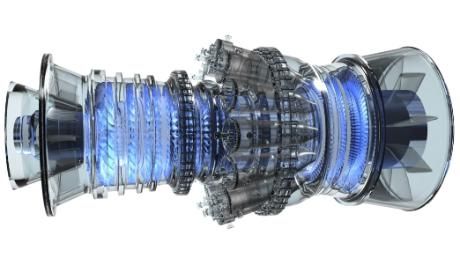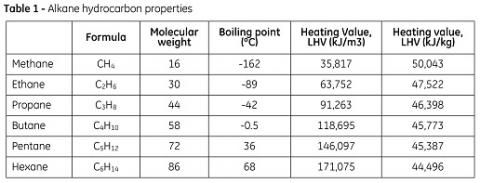What's next? Ethane as primary fuel for gas turbines?
Jeffrey Goldmeer & Scot Peever of GE Power presented a paper on ethane in gas turbines at Power Gen International, 2015. Below are excerpts from the paper:

The search for suitable alternatives included a variety of fuels and has led to projects that may operate on a variety of fuels, including lean methane, non-methane hydrocarbons, crude oil, and syngas. The category of non-methane hydrocarbons now includes ethane and propane, which are becoming available in suitable quantities due to shale gas production in the US.
The case for ethane is similar to propane, with supply increasing dramatically as natural gas liquids from shale gas in the United States have become more plentiful. However, ethane has traditionally been used exclusively as a feedstock for the petrochemical industry. With the increase in supply from unconventional gas production outpacing the current and potential future petrochemical demand, ethane is being considered as a fuel for power generation both in the United States and globally.
The concept of using ethane for power generation in the US is being validated by a new project in West Virginia. Moundsville Power recently announced plans to construct a combined cycle power plant, fueled by a combination of natural gas and ethane, enabled by expanding local fuel supplies.
The configuration of a combustor for a heavy-duty gas turbine needs to provide stable operability characteristics as well as capabilities such as turndown while meeting plant emissions criteria. These constraints are not independent and cannot be optimized separately. Fuels with increased (or reduced) heating value could have an increased risk of not meeting these criteria. For example, ethane is more reactive than natural gas which might lead to increased risk of combustion dynamics and/or flame flashback, or increased NOx emissions.
In a lean, premixed combustion system, flash back can occur when transient conditions allow the local flame speed to exceed the local air velocity and the flame is able to propagate upstream from the combustion zone into the pre-mixer or fuel nozzle. When this happens, the metal temperatures may increase to unacceptable levels and hardware damage may occur. In severe cases, the damage might require a forced outage.
Flame holding can occur after flashback if the flame attaches or “anchors” to the fuel nozzle. As with flashback, this might cause damage to combustion hardware. Using higher molecular weight hydrocarbons, such as ethane, can create additional risks for flashback as the laminar flame speed (or the speed at which the flame propagates upstream into the unburned fuel) is higher than that of methane. Although the flame speed for ethane is similar to that of methane, the flame speed for propane and butane can be two times faster than methane.
Operating a lean-premixed combustion system (also known as a dry low NOx or DLN combustion system) with hydrogen creates even larger flashback risks as its laminar flame speed is six to seven times faster than methane. GE determines the risk of flashback in a combustion system by examining the behavior during a forced ignition event performed during combustion testing. During this flame holding test, a torch is placed upstream of the fuel nozzle sending a flame through a pre-mixer for a short duration. Ideally, a pre-mixing fuel nozzle should be able to clear the flame after the torch is extinguished. This data is used during the development cycle to reduce the risk of flashback.
Combustion Dynamics
The phenomenon of combustion dynamics, also known as resonant pressure oscillations, arises from the interaction of the thermo-acoustic source (the flame) with the combustion hardware. Small changes in fuel/air concentration cause fluctuations in the flame’s heat release rate, which leads to pressure oscillations.
Shifts in fuel heating values may trigger combustion dynamics in some combustion systems. The potential for combustion dynamics can be higher in lean-premixed combustion systems (relative to diffusion flame systems) as there can be large changes in heat release for very small changes in fuel-air ratio. If left unchecked, these instabilities may impact gas turbine operability, and in worse-case scenarios, may cause degradation or damage to combustion hardware.

To mitigate the risk of combustion dynamics, GE employs multiple configuration and operational strategies to decouple the feedback loop between the flame and the fuel flow rate. These configuration based mitigations can be evaluated using analytics models and lab testing. GE gas turbines can also be configured with a sophisticated control system, known as OpFlexTM AutoTune that allows the gas turbine to accommodate changes in fuel heating value. This system includes an adaptive real-time engine simulation, which is a real-time, aero-thermal model of the gas turbine that supports physics-based boundary models. This system has been in operation for more than 8 years, has been installed on more than 130 gas turbines, and has accumulated more than one million operating hours.
Emissions
Operating on a more reactive fuel can increase flame temperature. Depending on the level of increase and gas turbine combustion configuration, this could impact NOx emissions. In the case of an ethane/natural gas blend, if the level of ethane is relatively small, the impact to NOx emissions may be negligible. However, as the amount of ethane increases, it has the potential to increase NOx, especially if operating in a DLN combustion system. If operating in a diffusion flame combustion system, some amount of diluent is always required to mitigate the high level of emissions associated with operating near stoichiometric conditions.
Evaluating fuels
As there can be significant variation in gas and liquid fuels, it is important to understand the overall fuel composition, and properties to properly assess impacts to performance and operability. This assessment should include fuel properties, as well as determining if the fuel contains any contaminants. To determine the viability of a new fuel, a multi-step process is employed to evaluate specific fuel characteristics and properties related to combustion and fuel handling.
Step 1 – Determine fuel source
Knowing the source of a fuel, the type of fuel (gas, unrefined liquid or refined liquid), potential fuel pre-treatments, and transport logistics are key to being able to determine the applicability of a fuel for a gas turbine. If the fuel is being taken directly from a well, are there any planned pre-treatments? What contaminants might be present in the fuel that could affect gas turbine operability, performance, or component durability? How will the fuel be transported to site, and might this introduce any variation or contaminants? These questions are important as they can provide insights into answers for the next steps.
For ethane and propane, it is important to understand if it would be pure or another commercial grade. For example, the HD-5 grade of propane allows for 90% propane with up to 5% propylene and 5% of other hydrocarbons.
Step 2 – Analytical fuel characterization
In order to be able to use a new fuel in a gas turbine, it is important to understand fuel composition and key properties. In the case of a gaseous fuel, a detailed listing of the percent (by volume) of each constituent gas is required to determine the heating value, Modified Wobbe Index, as well as potential risks from contaminants such as hydrogen sulfide. This information allows the fuel to be properly matched to the appropriate combustion system.
Details on GE’s requirements for fuel properties that should be tested along with suggested test methods are available in GE’s fuel specification documents. Once all of the required information has been collected, an initial determination of the applicability of the fuel can be made, and if viable, testing of specific fuel characteristics can proceed.
Step 3 – Fuel testing
The analytical examination of the fuel provides insights into combustion and/or fuel handling properties, which can determine the types of tests needed to evaluate the risk of using a new fuel. Typically, these are combustion tests that focus on determining emissions, combustion dynamics (combustion acoustics), and/or overall operability. These tests can also be run in a variety of facilities at a variety of scales.
A single nozzle combustion test facility is typically a simpler combustion system, requiring significantly less fuel, and allowing for additional instrumentation and more rapid testing.